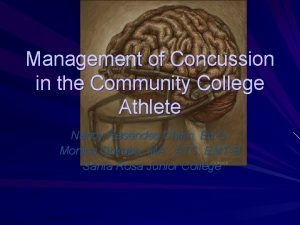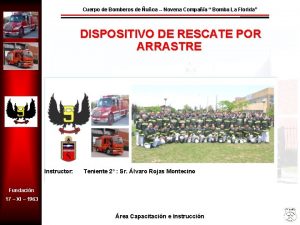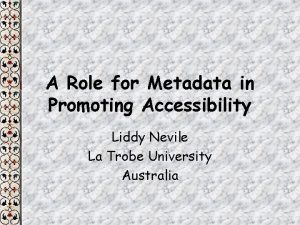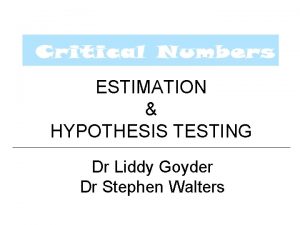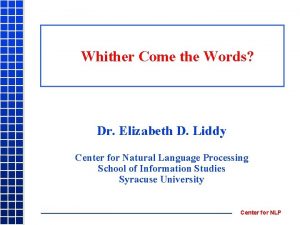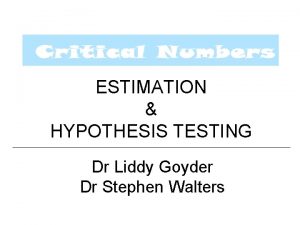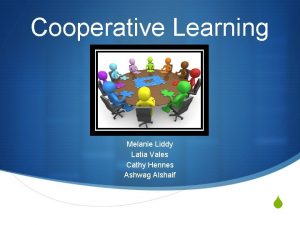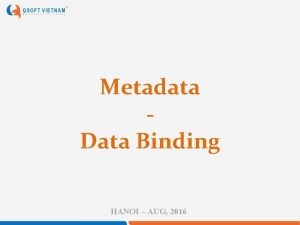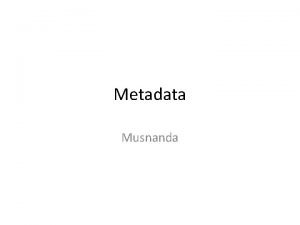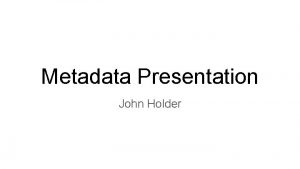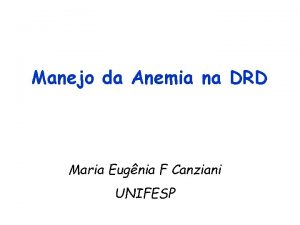Metadata for the GPII Liddy Nevile DRD metadata



























- Slides: 27

Metadata for the GPII Liddy Nevile

DRD metadata

GPII • Offers a chance for cumulative, crowdsourced, cloud-based, just-in-time provision of accessible resources through Access. For. All services. • Needs lots of quality metadata.

So let’s take a use case - a resource about dogs. • Martha’s preferred language is English, so when video is not in English, she wants English subtitles. • 6 am. to 6 pm. , the subtitles should be large. • 6 pm. to 6 am. , the subtitles should be extra large. • 9 am. to 7 pm. , the volume should be loud. • At other times, medium volume is OK. • The video brightness level should be at maximum brightness until 6 pm. • but 80% of its maximum brightness in the evenings.

There are two ways to find what we want: 1. a typical database method and 2. a typical metadata method

A database solution • • • If it is about dogs, does it have video? If so, is the time between 6 pm. and 6 am? If so, does it have extra large font subtitles? If so, is it after 7 pm. ? If so, does it have loud volume? If so, deliver it! The algorithmic approach to discovery based on lots of conditionals.

Behind the database solution Resource x Media type Time of day Font size v. small 6 am - 6 pm video text image small large 7 pm - 6 am midnight Extra large

A metadata solution Match • Media, time, font size, volume, to the metadata of the resource using standard ‘advanced search’ matching algorithm Note that changing size of font, e. g. might have to be implemented by a (cloud) service on the way.

Behind the metadata solution has medium video text image Resource x data property value …

A metadata solution has medium video Resource x data is video with subtitles property text small V small image large value … X large

Behind the metadata solution Video with volume low medium Resource x has medium video Video with subtitles data property text high image large small V small value … … X large

But, structure is often in the value • Perhaps, I have a general value - ‘loud. • Then I refined it to be more specific - ‘very loud’. • Then I refined it again to be more specific ‘low-pitch very loud. • Etc. (the core metadata value is loud and the refinements are structured so they are always associated with it)

Essentials for metadata • Sharing of metadata happens only if it is interoperable and that means interoperable syntax and interoperable semantics. • Interoperable semantics depends on a combination of common words and common structure. • So the GPII needs to specify common syntax, semantics and structure

What’s new, what’s available? • The syntax of the Semantic Web is already there and very interoperable with the various computer languages people use - not a problem if we use a standard syntax. • The semantics of terms, elements, vocabularies, whatever can be defined and published so everyone can share them.

But …. • The Semantic Web is ‘wonderful’ but too broad and unmanageable for us so, perhaps like the DC people, we will need to constrain it? • So let’s see what DC people do.

The ‘Semantic Web’ does what? • By having a very clear and atomic, uniform structure it supports computer decision-making and so linking of one data resource to another, sometimes extending across a chain of resources (because computers are capable of simple logic).

The ‘Semantic Web’ does what? • If a computer knows: – Fred is son of Bill and Mary – Tom is son of Bill and Mary • then Fred and Tom are brothers, and if – Bill and Mary have son Fred – Bill and Mary have son Tom • then Fred and Tom are brothers.

Semantic Web statements • They are ALWAYS the same VERY simple statements subject, relationship, value • i. e. there is an invariable structure. • Note that this is the case even when we have – Tom is son of Bill and Mary, and – Bill and Mary have son Tom. • The structure is really important.

Dublin Core statements • DC metadata people use the Sem. Web but they don’t (yet) use it backwards and forwards. They say: – (the story) My Holidays was written by Jack, and – My Holidays was published by PBS • because they tend to want to keep the descriptions of the story together, and elsewhere they describe the author, for simplicity. • But using Sem. Web technology, one can associate a description of what PBS publishes with what is known about Jack, or the story My Holidays.

Dublin Core statements • Graphically, the difference is between a set of descriptions all flowing from single resources, even when they are later linked up (DC metadata), and a web where all sorts of things are linked one to another (in any direction). • Either way, both use triples.

DC Metadata (bottom) and the Semantic Web (top)

Making metadata for ISO 24751 The steps are: – Analyse and determine the needs of the client base (use domain expertise) – Sort the properties (domain and metadata expertise) – Represent the properties using the Resource Description Framework – Provide examples of encoding of metadata – Develop cross-walks where necessary

Making good metadata


Simple PNP descriptions • People can be in a hurry and want immediate changes to their resources. • A wizard can solve this problem, only presenting the detailed or complicated possibilities if they are indicated by the user.

Other important notes • Metadata is generated in many ways - by people, by workflow processes, by usage (paradata), etc. • Full-text searches etc are not useless - they are just different (and complementary, in most cases) • Quantity has a quality all of its own but in the field of accessibility, quantity is not common. Remember, we are aiming to support the user’s choice, not to impose constraints on their access to resources!

• Thank you!
 Liddy mignone
Liddy mignone Drd srjc
Drd srjc Drd bomberos
Drd bomberos Woningwaarde schatten
Woningwaarde schatten 1852.234-2 nasa far evms supplement clause
1852.234-2 nasa far evms supplement clause Xx
Xx Förklara densitet för barn
Förklara densitet för barn Elektronik för barn
Elektronik för barn Tack för att ni har lyssnat
Tack för att ni har lyssnat Borra hål för knoppar
Borra hål för knoppar Smärtskolan kunskap för livet
Smärtskolan kunskap för livet Bris för vuxna
Bris för vuxna Anatomi organ reproduksi
Anatomi organ reproduksi Trög för kemist
Trög för kemist Argument för teckenspråk som minoritetsspråk
Argument för teckenspråk som minoritetsspråk Typiska drag för en novell
Typiska drag för en novell Enheter för massa
Enheter för massa Delegerande ledarstil
Delegerande ledarstil Ellika andolf
Ellika andolf Blomman för dagen drog
Blomman för dagen drog Redogör för vad psykologi är
Redogör för vad psykologi är En lathund för arbete med kontinuitetshantering
En lathund för arbete med kontinuitetshantering Mat för unga idrottare
Mat för unga idrottare Gumman cirkel sång
Gumman cirkel sång Publik sektor
Publik sektor Etik och ledarskap etisk kod för chefer
Etik och ledarskap etisk kod för chefer Datorkunskap för nybörjare
Datorkunskap för nybörjare Fredsgudinna pax
Fredsgudinna pax

